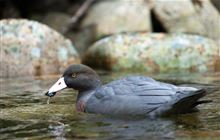It takes a community to raise a whio
Archived content: This media release was accurate on the date of publication.
Introduction
Today marks the start of Whio Awareness Month, where we celebrate all the hard work that goes into making a brighter future for whio.Date: 01 April 2018
This month DOC and Genesis Energy and their community partners celebrate the success of concerted efforts by many parties to improve the prospects for New Zealand’s river rapid-riding blue duck.
Today, whio pairs on 22 key river habitats have risen to just over 600, up from just 250 in 2009. In the same period, the length of river protected from predators has increased from about 600km to nearly 1600km.
Andrew Glaser, DOC Recovery Group Leader for the Whio Forever Programme says that the increase in numbers is due to the combined efforts of predator control and the introduction and growth of captive rearing and breeding programmes.
"This means our rivers are safer for the whio living and breeding on them, and the wild populations are getting a boost to increase the numbers more quickly than could happen if the birds were left to breed without assistance".
This help comes from many individuals, community groups, charitable trusts and businesses. "We simply couldn't achieve what we have without the combined effort of everyone", says Andrew Glaser.
Over the past year, the efforts of captive facilities like Christchurch-based The Isaac Conservation and Wildlife Trust, have added nearly 80 captive-bred whio to wild populations, and a multitude of trapping initiatives have increased the length of rivers protected by over 100km.
The Isaac Conservation and Wildlife Trust facility receives whio eggs from four sites around the South Island and incubates them. The Trust also holds a captive breeding pair and incubates eggs from whio pairs held in captivity at the Queenstown Birdlife Park and Willowbank Wildlife Reserve.
Once the chicks have hatched they are joined by ducklings hatched and reared at Orana Wildlife Park and released in an aviary where they learn rivercraft and food hunting skills. The aviary has a specially-built white water hazard course. After three months the young whio graduate from this boot camp and are released back into the wild.
In the North Island the captive breeding pairs of whio are held at the Esplanade Aviary, Palmerston North; Pukaka Mount Bruce; Hamilton Zoo; Auckland Zoo; Nga Manu Nature Reserve; Otorohanga Kiwi House; Staglands and Rainbow Springs Nature Park and The Isaac Conservation and Wildlife Trust.
Once the ducklings are old enough they are then transferred to the Whio Hardening Centre at the Tongariro National Trout Centre to become accustomed to fast water before being released to the wild.
Andrew Glaser says that getting live ducks into the world is only part of the solution.
"Stoats are a disaster for whio, they kill nesting females, steal eggs and slaughter ducklings. Extensive and intensive predator control is an essential ingredient of success."
This work is undertaken by a range of dedicated nature lovers – from individual trappers who enjoy helping out in nature, large community groups organising rosters of trap checks, to landscape scale predator control by DOC and other groups. To all those that help – a big whio shout out to you all."
Contact
For media enquiries contact:
Email: media@doc.govt.nz


